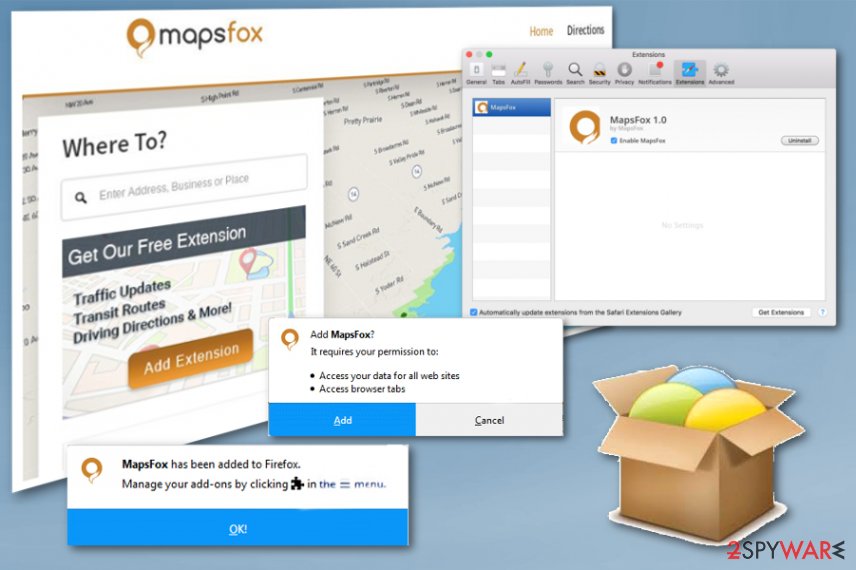MapsFox (Free Guide) - 2019 update
MapsFox Removal Guide
What is MapsFox?
MapsFox is the adware-type program that shows commercial content constantly and installs additional MapsFox browser extension without your permission

MapsFox is the program that might be advertised as providing accurate and useful features. Unfortunately, there is no feature that includes giving accurate directions, transit routes or reports traffic. Although these features may look valuable and legitimate, this PUP is not giving you positive results.[1] Adware delivers commercial content and fills up the browser with intrusive advertisements. Some computer users, who have been using the Chrome browser, claim that they have been experiencing MapsFox pop-up ads on expeditorsonline.com. According to various complaints online, this intruder affects both operating systems.[2] Once the program hijacks your Windows or Mac device, you might start overcoming advertisements which say that they are “Brought to you by MapsFox,” “Advertisements by MapsFox,” and similar. Clicking on this content redirects your online traffic to affiliated pages or even exposes to malicious online content.
| Name | MapsFox |
|---|---|
| Category | Adware |
| Sub-category | PUP (potentially unwanted program) |
| Browsers hijacked | Chrome is the most popular browser, so it gets infected more than others, but other web browsers also might be hijacked by the adware |
| OS affected | Mac or Windows |
| Identification | You can identify this program by rogue advertising activities which let you know that ads are “Brought to you by MapsFox,” also, from redirecting |
| Distribution | Other free programs, unsafe websites, infected hyperlinks, etc. |
| Detection process | Try detecting the potentially unwanted program and all rogue content with FortectIntego |
MapsFox advertising is the main frustrating feature of the adware program because, in most cases, banners, pop-up ads or in-text advertisements, coupons promote useless products, fake software updates, other websites. Colorful windows contain little information but no close button that could allow closing the advertisements directly and quickly.
As many other potentially unwanted programs, adware installs applications or programs without your knowledge and consent like MapsFox extension on your Mozilla Firefox, Google Chrome or any other browser. This additional content affects the speed and performance of your device, so you need to eliminate all related programs from the system.
You can see that MapsFox advertisements display direct identification that this program generates unwanted content. This way you can see what PUP is affecting your computer:
- MapsFox Promos,
- Powered by MapsFox,
- Advertisements by MapsFox,
- Brought to you by MapsFox,
- Ads by MapsFox,
- Ads powered by MapsFox.
MapsFox ads can appear in your computer system after installing rogue applications from free third-party sources. Additionally, these types of programs might come from dubious links. Once they do, your web browser is very likely to experience changes like added toolbars or changed homepage.
Nevertheless, MapsFox pop-up ads can cause dubious redirects to questionable-looking websites. Sadly, some of these pages might appear to be potentially dangerous and seak to install malware on the visitor's computer. Moreover, these adverts often promote rogue security software or offer other useless programs to gain income.

MapsFox is an adware application which means that it can collect browsing-related details. Potentially unwanted programs are very likely to gather all information that relates to the user's browsing activity, history, and habits. Once this data is collected, the developers can moderate beneficially-looking advertisements which are promoted to trick users to click on these notifications.
Additionally, ad-supported programs can cause browser struggles and even crashes. Moreover, these PUPs eat the computer's resources; they might also overuse the CPU's[3] energy to provide numerous advertising posts. For these reasons, you should remove MapsFox as soon as you spot rogue changes in your computer and the program running in the system.
MapsFox removal should be performed cautiously. If you do not feel experienced enough to deal with the PUP by yourself, you should use a tool such as FortectIntego to eliminate the rogue app. However, we have provided a manual elimination guide below this text for those who are likely to get rid of the cyber threat on their own. Make sure you take a good look at the below-provided instructions to succeed in the process.

Adware programs come from third-party Internet sources
According to cybersecurity experts from Virusai.lt,[4] adware applications can be found all over the web. However, mostly, these programs appear on third-party websites. These pages can also be free downloading websites from which adware apps infiltrate the system together with other software. Good news is that you can avoid this type of secret installation.
What you have to do is choose the Advanced installation mode in your web browser. This variant allows you to track all incoming programs and opt-out components you do not want to see on your computer. Furthermore, you should always pay attention to the objects you are downloading and installing on your own. DO NOT skip any steps.
If you like to visit various questionable pages daily, you should get an antivirus program to protect your system all the time. Of course, the best choice would be to stay away from all rogue content from the Internet sphere. Additionally, be careful while clicking on hyperlinks, they also might have adware, or even malware injected, better investigate them first.
Get rid of MapsFox pop-up notifications from your OS and web browser
To remove MapsFox from your computer system and web browser, choose reliable computer software or perform the process by using our below-given manual elimination guide. Note that you will need to get rid of each browser extension, plug-in, and add-on. Do not forget to test all browsers, otherwise, you might miss particular signs of adware.
For the MapsFox removal, check web browsers such as Google Chrome, Mozilla Firefox, Microsoft Edge, Internet Explorer, and Safari. Note that the elimination requires full attention and some skills. If you think that you lack experience, better choose a reputable anti-malware program to complete the removal process as these tools will guide you through.
You may remove virus damage with a help of FortectIntego. SpyHunter 5Combo Cleaner and Malwarebytes are recommended to detect potentially unwanted programs and viruses with all their files and registry entries that are related to them.
Getting rid of MapsFox. Follow these steps
Uninstall from Windows
If you have overcome rogue advertisements on your Windows computer, you can get rid of them by following these instructing steps:
Instructions for Windows 10/8 machines:
- Enter Control Panel into Windows search box and hit Enter or click on the search result.
- Under Programs, select Uninstall a program.

- From the list, find the entry of the suspicious program.
- Right-click on the application and select Uninstall.
- If User Account Control shows up, click Yes.
- Wait till uninstallation process is complete and click OK.

If you are Windows 7/XP user, proceed with the following instructions:
- Click on Windows Start > Control Panel located on the right pane (if you are Windows XP user, click on Add/Remove Programs).
- In Control Panel, select Programs > Uninstall a program.

- Pick the unwanted application by clicking on it once.
- At the top, click Uninstall/Change.
- In the confirmation prompt, pick Yes.
- Click OK once the removal process is finished.
Delete from macOS
Spotting MapsFox pop-up ads on Mac means that supposedly an adware app has infiltrated the system unexpectedly. Eliminate the potentially unwanted program with the help of these instructions:
Remove items from Applications folder:
- From the menu bar, select Go > Applications.
- In the Applications folder, look for all related entries.
- Click on the app and drag it to Trash (or right-click and pick Move to Trash)

To fully remove an unwanted app, you need to access Application Support, LaunchAgents, and LaunchDaemons folders and delete relevant files:
- Select Go > Go to Folder.
- Enter /Library/Application Support and click Go or press Enter.
- In the Application Support folder, look for any dubious entries and then delete them.
- Now enter /Library/LaunchAgents and /Library/LaunchDaemons folders the same way and terminate all the related .plist files.

Remove from Microsoft Edge
Delete unwanted extensions from MS Edge:
- Select Menu (three horizontal dots at the top-right of the browser window) and pick Extensions.
- From the list, pick the extension and click on the Gear icon.
- Click on Uninstall at the bottom.

Clear cookies and other browser data:
- Click on the Menu (three horizontal dots at the top-right of the browser window) and select Privacy & security.
- Under Clear browsing data, pick Choose what to clear.
- Select everything (apart from passwords, although you might want to include Media licenses as well, if applicable) and click on Clear.

Restore new tab and homepage settings:
- Click the menu icon and choose Settings.
- Then find On startup section.
- Click Disable if you found any suspicious domain.
Reset MS Edge if the above steps did not work:
- Press on Ctrl + Shift + Esc to open Task Manager.
- Click on More details arrow at the bottom of the window.
- Select Details tab.
- Now scroll down and locate every entry with Microsoft Edge name in it. Right-click on each of them and select End Task to stop MS Edge from running.

If this solution failed to help you, you need to use an advanced Edge reset method. Note that you need to backup your data before proceeding.
- Find the following folder on your computer: C:\\Users\\%username%\\AppData\\Local\\Packages\\Microsoft.MicrosoftEdge_8wekyb3d8bbwe.
- Press Ctrl + A on your keyboard to select all folders.
- Right-click on them and pick Delete

- Now right-click on the Start button and pick Windows PowerShell (Admin).
- When the new window opens, copy and paste the following command, and then press Enter:
Get-AppXPackage -AllUsers -Name Microsoft.MicrosoftEdge | Foreach {Add-AppxPackage -DisableDevelopmentMode -Register “$($_.InstallLocation)\\AppXManifest.xml” -Verbose

Instructions for Chromium-based Edge
Delete extensions from MS Edge (Chromium):
- Open Edge and click select Settings > Extensions.
- Delete unwanted extensions by clicking Remove.

Clear cache and site data:
- Click on Menu and go to Settings.
- Select Privacy, search and services.
- Under Clear browsing data, pick Choose what to clear.
- Under Time range, pick All time.
- Select Clear now.

Reset Chromium-based MS Edge:
- Click on Menu and select Settings.
- On the left side, pick Reset settings.
- Select Restore settings to their default values.
- Confirm with Reset.

Remove from Mozilla Firefox (FF)
Remove dangerous extensions:
- Open Mozilla Firefox browser and click on the Menu (three horizontal lines at the top-right of the window).
- Select Add-ons.
- In here, select unwanted plugin and click Remove.

Reset the homepage:
- Click three horizontal lines at the top right corner to open the menu.
- Choose Options.
- Under Home options, enter your preferred site that will open every time you newly open the Mozilla Firefox.
Clear cookies and site data:
- Click Menu and pick Settings.
- Go to Privacy & Security section.
- Scroll down to locate Cookies and Site Data.
- Click on Clear Data…
- Select Cookies and Site Data, as well as Cached Web Content and press Clear.

Reset Mozilla Firefox
If clearing the browser as explained above did not help, reset Mozilla Firefox:
- Open Mozilla Firefox browser and click the Menu.
- Go to Help and then choose Troubleshooting Information.

- Under Give Firefox a tune up section, click on Refresh Firefox…
- Once the pop-up shows up, confirm the action by pressing on Refresh Firefox.

Remove from Google Chrome
If you have found the MapsFox extension in your Google Chrome web browser, you can get rid of the unwanted component by looking through these instructions:
Delete malicious extensions from Google Chrome:
- Open Google Chrome, click on the Menu (three vertical dots at the top-right corner) and select More tools > Extensions.
- In the newly opened window, you will see all the installed extensions. Uninstall all the suspicious plugins that might be related to the unwanted program by clicking Remove.

Clear cache and web data from Chrome:
- Click on Menu and pick Settings.
- Under Privacy and security, select Clear browsing data.
- Select Browsing history, Cookies and other site data, as well as Cached images and files.
- Click Clear data.

Change your homepage:
- Click menu and choose Settings.
- Look for a suspicious site in the On startup section.
- Click on Open a specific or set of pages and click on three dots to find the Remove option.
Reset Google Chrome:
If the previous methods did not help you, reset Google Chrome to eliminate all the unwanted components:
- Click on Menu and select Settings.
- In the Settings, scroll down and click Advanced.
- Scroll down and locate Reset and clean up section.
- Now click Restore settings to their original defaults.
- Confirm with Reset settings.

Delete from Safari
Remove unwanted extensions from Safari:
- Click Safari > Preferences…
- In the new window, pick Extensions.
- Select the unwanted extension and select Uninstall.

Clear cookies and other website data from Safari:
- Click Safari > Clear History…
- From the drop-down menu under Clear, pick all history.
- Confirm with Clear History.

Reset Safari if the above-mentioned steps did not help you:
- Click Safari > Preferences…
- Go to Advanced tab.
- Tick the Show Develop menu in menu bar.
- From the menu bar, click Develop, and then select Empty Caches.

After uninstalling this potentially unwanted program (PUP) and fixing each of your web browsers, we recommend you to scan your PC system with a reputable anti-spyware. This will help you to get rid of MapsFox registry traces and will also identify related parasites or possible malware infections on your computer. For that you can use our top-rated malware remover: FortectIntego, SpyHunter 5Combo Cleaner or Malwarebytes.
How to prevent from getting adware
Protect your privacy – employ a VPN
There are several ways how to make your online time more private – you can access an incognito tab. However, there is no secret that even in this mode, you are tracked for advertising purposes. There is a way to add an extra layer of protection and create a completely anonymous web browsing practice with the help of Private Internet Access VPN. This software reroutes traffic through different servers, thus leaving your IP address and geolocation in disguise. Besides, it is based on a strict no-log policy, meaning that no data will be recorded, leaked, and available for both first and third parties. The combination of a secure web browser and Private Internet Access VPN will let you browse the Internet without a feeling of being spied or targeted by criminals.
No backups? No problem. Use a data recovery tool
If you wonder how data loss can occur, you should not look any further for answers – human errors, malware attacks, hardware failures, power cuts, natural disasters, or even simple negligence. In some cases, lost files are extremely important, and many straight out panic when such an unfortunate course of events happen. Due to this, you should always ensure that you prepare proper data backups on a regular basis.
If you were caught by surprise and did not have any backups to restore your files from, not everything is lost. Data Recovery Pro is one of the leading file recovery solutions you can find on the market – it is likely to restore even lost emails or data located on an external device.
- ^ "Potentially Unwanted Programs": much more than just annoying. Gdatasoftware. Data security blog.
- ^ Delete MapsFox. Mac-forums. Community forum for Mac users.
- ^ CPU. Computer hope. Free computer help since 1998.
- ^ Virusai.lt. Virusai. Spyware news and technology information.
